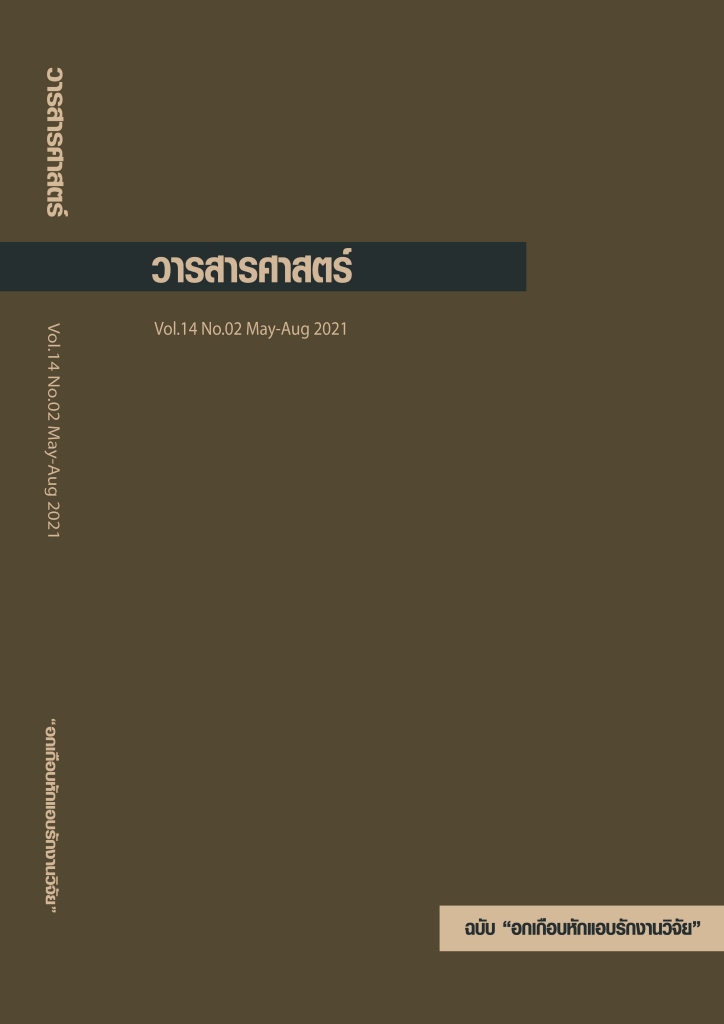ข่าวปลอมกับการทำงานของนักข่าวในยุคดิจิทัล
คำสำคัญ:
ข่าวปลอม, งานของนักข่าว, กระบวนการตรวจสอบบทคัดย่อ
ท่ามกลางความก้าวหน้าทางเทคโนโลยีสื่อสารยุคดิจิทัลที่เปิดโอกาสให้ ผู้ใช้งานอินเทอร์เน็ตสามารถสร้างสรรค์เนื้อหาสื่อสารด้วยตนเอง และเปิดให้ แบ่งปันเนื้อหาแก่ผู้อื่นได้โดยง่าย ด้านหนึ่งเป็นการเปิดให้โลกแห่งข่าวสาร ไหลเวียนได้ง่ายขึ้น แต่อีกด้านกลับประสบปัญหาสำคัญที่ผู้รับสารไม่อาจแยกแยะ ได้ชัดว่า อะไรคือข้อเท็จจริง (fact) อะไรคือข่าวปลอม (fake) บทความนี้จึง มีวัตถุประสงค์เพื่อตรวจสอบความหมายของข่าวปลอมในบริบทยุคดิจิทัล และ เพื่อเสนอกระบวนการตรวจสอบข่าวปลอมให้แก่นักข่าวและผู้ใช้สื่อ บทความใช้ ระเบียบวิธีวิจัยเชิงเอกสาร (documentary research) สำรวจและวิเคราะห์ข้อมูล ตัวอย่างจากต่างประเทศเพื่อนำมาปรับใช้กับประเทศไทย จากการศึกษาพบว่า ข่าวปลอมที่ถกเถียงในปัจจุบันอาจไม่ใช่เรื่องใหม่นัก เพราะเคยปรากฏตัวอย่าง มายาวนาน แต่นิยามข่าวปลอมในบริบทใหม่ยุคดิจิทัลกลับมีความซับซ้อนมากขึ้น บทความนี้พบว่า ลักษณะข่าวปลอมที่เกิดขึ้นในชุมชนออนไลน์ปัจจุบันมีอย่างน้อย 3 รูปแบบ คือ (1) โฆษณาประชาสัมพันธ์ให้ดูเหมือนข่าวจริง (2) การประชด ประชันเสียดสีล้อเลียนที่เนื้อหาผิดไปจากข้อเท็จจริง (3) ตั้งใจสร้างข่าวเพื่อหวัง ผลทางการเมืองทำให้คนเกิดอารมณ์ร่วมแบ่งฝ่าย ทั้ง 3 รูปแบบนี้มีมิติร่วมใน การผลิตข่าวปลอมคือ การไม่นำเสนอข้อเท็จจริงอย่างถึงที่สุด (facticity) และการลวง (deception) เพื่อบรรลุเป้าหมายของตน นอกจากนี้ บทความยังเสนอ ให้นักข่าวควรมีกระบวนการตรวจสอบข่าวปลอมอย่างเป็นระบบ และมีความเป็น มืออาชีพมากขึ้นด้วย
เอกสารอ้างอิง
Allcott, H. and Gentzkow, M. (2017). “Social Media and Fake News in the 2016 Election”, Journal of Economic Perspectives, 31(2): 211-236.
Bakir, V. and McStay, A. (2018). “Fake News and the Economy of Emotions: Problems, Causes, Solutions”, Digital Journalism, 6(2): 154-175.
Balmas, M. (2014), “When Fake News Becomes Real: Combined Exposure to Multiple News Sources and Political Attitudes of Inefficacy, Alienation, and Cynicism”, Communication Research, 41(3): 430-454.
Borden, S. and Tew, C. (2007), “The Role of Journalist and the Performance of Journalism: Ethical Lessons From “Fake” News (Seriously)”, Journal of Mass Media Ethics, 22(4): 300-314.
Cantril, H. (2005), The Invasion from Mars, New Jersey: Princeton University Press. Chu, Z. et al. (2012), “Detecting Automation of Twitter Accounts: Are you a Human, Bot, or Cyborg?”, IEEE Transactions on Dependable and Secure Computing,9(6): 811-824.
Dentith, M. (2017), “The Problem of Fake News”, Public Reason 8(1-2): 65-79.
Gelfert, A. (2018), “Fake News: A Definition”, Informal Logic, 38(1), 84-117.
Hill, S. and Bradshaw, P. (2019), Mobile-First Journalism: Producing News for Social and Interactive Media, London: Routledge.
Kovach, B. and Rosenstiel, T. (2014), The Elements of Journalism, New York: Three Rivers Press.
Marcus, J. (1993), Mesoamerican Writing Systems: Propaganda, Myth, and History in Four Ancient Civilizations, New Jersey: Princeton University Press.
Rubin, V. et al. (2015). “Deception Detection for News: Three Types of Fakes”, Proceedings of the Association for Information Science and Technology, 52(1): 1-4.
________. (2016), “Fake News or Truth? Using Satirical Cues to Detect Potentially Misleading News”, Proceedings of NAACL-HLT, 7: 17.
Schifferes, S. et al. (2014), “Identifying and Verifying News through Social Media”, Digital Journalism, 2(3): 406-418.
Shu, K. et al. (2017), “Fake News Detection on Social Media: A Data Mining Perspective”, SIGKDD Explore News, 19(1): 22-36.
Tandoc, E. et al. (2017), “Defining Fake News”, Digital Journalism, 6(2): 137-153.
Tylor, J. (2014), “An Examination of How Student Journalists Seek Information and Evaluate Online Sources during the Newsgathering Process”, New Media & Society 17(8): 1277-1298.
ฐิติมา อุรพีพัฒนพงศ์ (2561), “สงครามแฮชแท็กจากเหตุยิงที่ฟลอริดา เป้าหมายของเกรียนคืออะไร”, สืบค้นเมื่อ 26 ตุลาคม 2561 จาก https://themomentum.co/russian-trolls-flood-twitter-shooting/
เนชั่นสุดสัปดาห์ (2562), “เปิดแล้ว ‘ศูนย์ต้านเฟคนิวส์” พุทธิพงษ์ จัดให้ เล็งจัดการข่าวเท็จ 4 กลุ่ม’”, สืบค้นเมื่อ 2 มกราคม 2563 จาก https://www.nationweekend.com/content/polistics/2499?fbclid=IwAR3DR68_xR0kX02ma76fTqdpS75Qvu420OC6NOG-FZjr23DpjPB-BSFHHxts
Attkisson, S. (2018), “How Real Is Fake News? TEDx University of Nevada confer-ence”, retrieved 26 October 2019 from https://sharylattkisson.com/2018/02/is-fake-news-real/
BBC (2017), “Restaurant Hit by ‘Human Meat’ Fake News Claims”, retrieved 26 October2018 from http://www.bbc.co.uk/newsbeat/article/39966215/restaurant-hit-by-human-meat-fake-news-claims
BBC News (2017), “Facebook Ditches Fake News Warning Flag”, TECH, retrieved 6 October 2020 from https://www.bbc.com/news/technology-42438750
Bessi, A. and Ferrara, E. (2016), “Social Bots Distort the 2016 US Presidential Election Online Discussion”, First Monday, 21(11), retrieved 29 June 2019 from https://firstmonday.org/article/view/7090/5653
Byrnes, J. (2017), “Trump: CNN is 'Garbage Journalism'”, retrieved 26 October 2018 from https://thehill.com/homenews/administration/340350-trump-cnn-is-garbage-journalism
European Commission (2020), “Code of Practice on Disinformation”, Shaping Europe’s Digital Future, retrieved 3 October 2020 from https://ec.europa.eu/digital-single-market/en/tackling-online-disinformation
Mosseri, A. (2016), “Building a Better News Feed for You”, retrieved 20 October 2019 from https://newsroom.fb.com/news/2016/06/building-a-better-news-feed-for-you/
Ritchie, H. (2016), “Read All about It: The Biggest Fake News Stories of 2016”, retrieved 20 October 2019 from https://www.cnbc.com/2016/12/30/read-all-about-it-the-biggest-fake-news-stories-of-2016.html
Roig-Franzia, M. (2016), “How Alex Jones, conspiracy theorist extraordinaire, got Donald Trump's ear”, The Washington Post, retrieved 6 October 2020 from https://www.washingtonpost.com/lifestyle/style/how-alex-jones-conspiracy-theorist-extraordinaire-got-donald-trumps-ear/2016/11/17/583dc190-ab3e-11e6-8b45-f8e493f06fcd_story.html
Shukla, S. and Lyons, T. (2017), “Blocking Ads from Pages that Repeatedly Share False News”, retrieved 26 September 2019 from https://newsroom.fb.com/news/2017/08/blocking-ads-from-pages-that-repeatedly-share-false-news/
South China Morning Post (16 December 2016), “Facebook to Red-Flag Fake News with Help of its Users and Third-Party Fact-Checkers”, retrieved 8 October 2020 from https://www.scmp.com/news/world/article/2055104/facebook-red-flag-fake-news-help-its-users-and-third-party-fact-checkers
Silverman, C. (2016), “This Analysis Shows How Viral Fake Election News Stories Outper-formed Real News on Facebook”, retrieved 26 October 2018 from https://www.buzzfeednews.com/article/craigsilverman/viral-fake-election-news-outperformed-real-news-on-facebook#.bp90yKJ1W
TCIJ (2562), “ส่อง 5 ข่าวปลอม-ข่าวลือที่ไม่เป็นจริงในโซเชียล ครึ่งปี 2562”, สืบค้นเมื่อ 3 มกราคม 2563 จาก https://www.tcijthai.com/news/2019/8/current/9324








